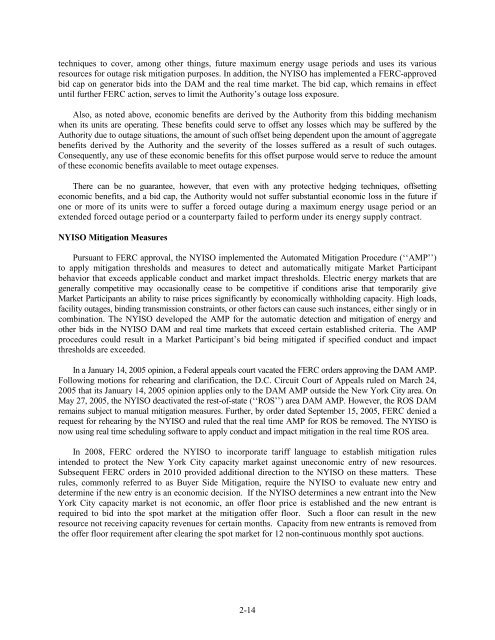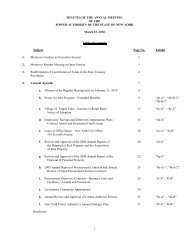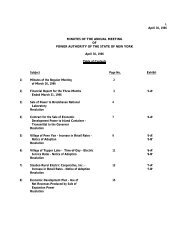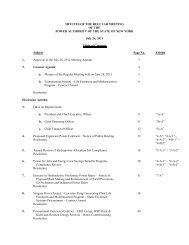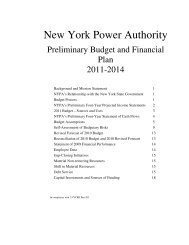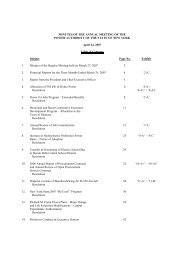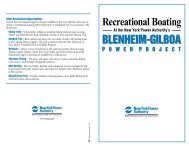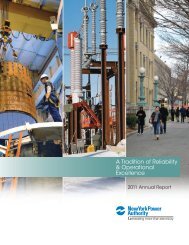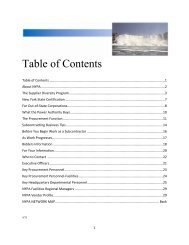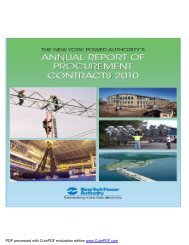July (pdf) - New York Power Authority
July (pdf) - New York Power Authority
July (pdf) - New York Power Authority
Create successful ePaper yourself
Turn your PDF publications into a flip-book with our unique Google optimized e-Paper software.
techniques to cover, among other things, future maximum energy usage periods and uses its various<br />
resources for outage risk mitigation purposes. In addition, the NYISO has implemented a FERC-approved<br />
bid cap on generator bids into the DAM and the real time market. The bid cap, which remains in effect<br />
until further FERC action, serves to limit the <strong>Authority</strong>’s outage loss exposure.<br />
Also, as noted above, economic benefits are derived by the <strong>Authority</strong> from this bidding mechanism<br />
when its units are operating. These benefits could serve to offset any losses which may be suffered by the<br />
<strong>Authority</strong> due to outage situations, the amount of such offset being dependent upon the amount of aggregate<br />
benefits derived by the <strong>Authority</strong> and the severity of the losses suffered as a result of such outages.<br />
Consequently, any use of these economic benefits for this offset purpose would serve to reduce the amount<br />
of these economic benefits available to meet outage expenses.<br />
There can be no guarantee, however, that even with any protective hedging techniques, offsetting<br />
economic benefits, and a bid cap, the <strong>Authority</strong> would not suffer substantial economic loss in the future if<br />
one or more of its units were to suffer a forced outage during a maximum energy usage period or an<br />
extended forced outage period or a counterparty failed to perform under its energy supply contract.<br />
NYISO Mitigation Measures<br />
Pursuant to FERC approval, the NYISO implemented the Automated Mitigation Procedure (‘‘AMP’’)<br />
to apply mitigation thresholds and measures to detect and automatically mitigate Market Participant<br />
behavior that exceeds applicable conduct and market impact thresholds. Electric energy markets that are<br />
generally competitive may occasionally cease to be competitive if conditions arise that temporarily give<br />
Market Participants an ability to raise prices significantly by economically withholding capacity. High loads,<br />
facility outages, binding transmission constraints, or other factors can cause such instances, either singly or in<br />
combination. The NYISO developed the AMP for the automatic detection and mitigation of energy and<br />
other bids in the NYISO DAM and real time markets that exceed certain established criteria. The AMP<br />
procedures could result in a Market Participant’s bid being mitigated if specified conduct and impact<br />
thresholds are exceeded.<br />
In a January 14, 2005 opinion, a Federal appeals court vacated the FERC orders approving the DAM AMP.<br />
Following motions for rehearing and clarification, the D.C. Circuit Court of Appeals ruled on March 24,<br />
2005 that its January 14, 2005 opinion applies only to the DAM AMP outside the <strong>New</strong> <strong>York</strong> City area. On<br />
May 27, 2005, the NYISO deactivated the rest-of-state (‘‘ROS’’) area DAM AMP. However, the ROS DAM<br />
remains subject to manual mitigation measures. Further, by order dated September 15, 2005, FERC denied a<br />
request for rehearing by the NYISO and ruled that the real time AMP for ROS be removed. The NYISO is<br />
now using real time scheduling software to apply conduct and impact mitigation in the real time ROS area.<br />
In 2008, FERC ordered the NYISO to incorporate tariff language to establish mitigation rules<br />
intended to protect the <strong>New</strong> <strong>York</strong> City capacity market against uneconomic entry of new resources.<br />
Subsequent FERC orders in 2010 provided additional direction to the NYISO on these matters. These<br />
rules, commonly referred to as Buyer Side Mitigation, require the NYISO to evaluate new entry and<br />
determine if the new entry is an economic decision. If the NYISO determines a new entrant into the <strong>New</strong><br />
<strong>York</strong> City capacity market is not economic, an offer floor price is established and the new entrant is<br />
required to bid into the spot market at the mitigation offer floor. Such a floor can result in the new<br />
resource not receiving capacity revenues for certain months. Capacity from new entrants is removed from<br />
the offer floor requirement after clearing the spot market for 12 non-continuous monthly spot auctions.<br />
2-14


